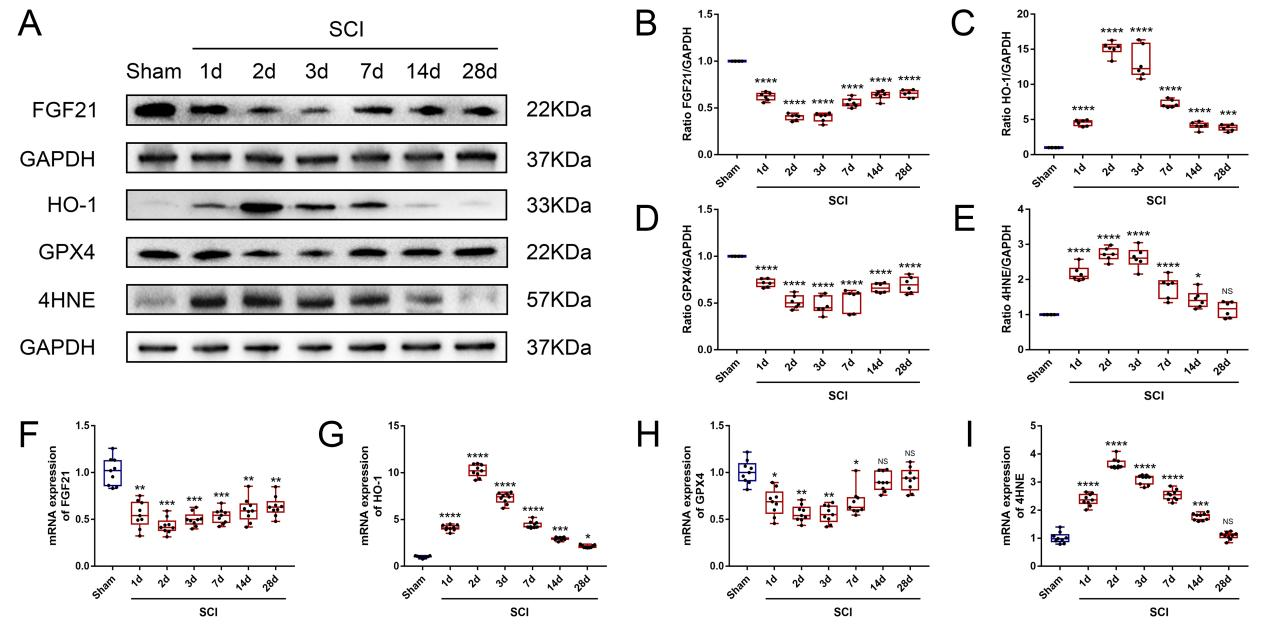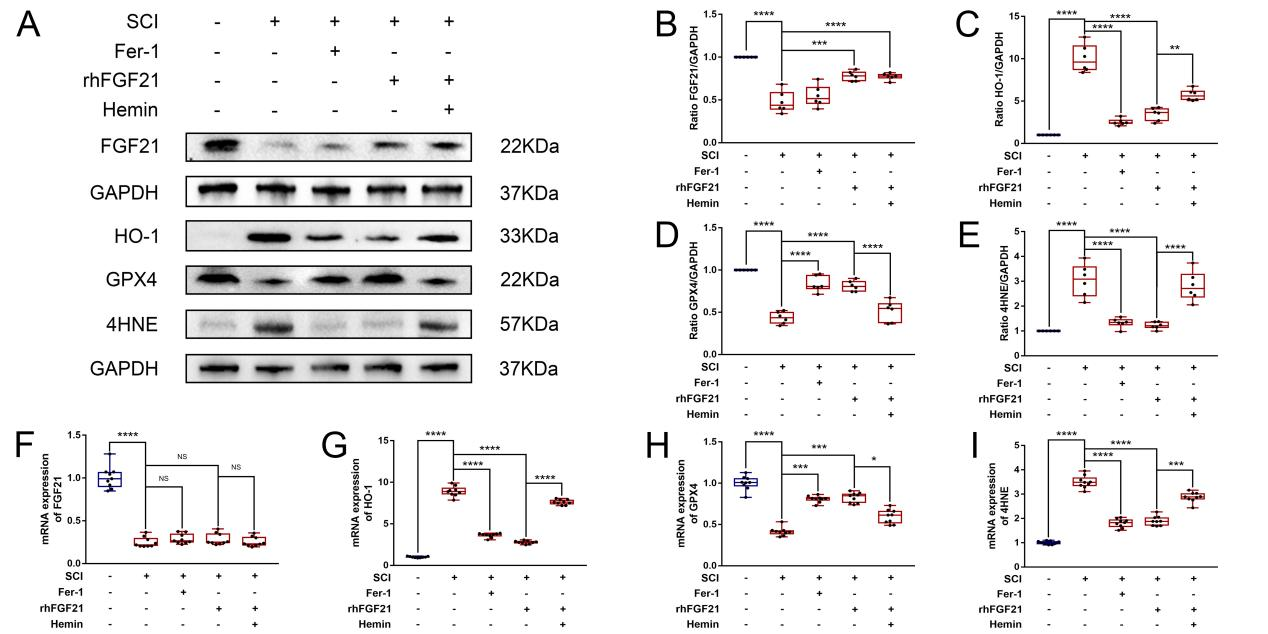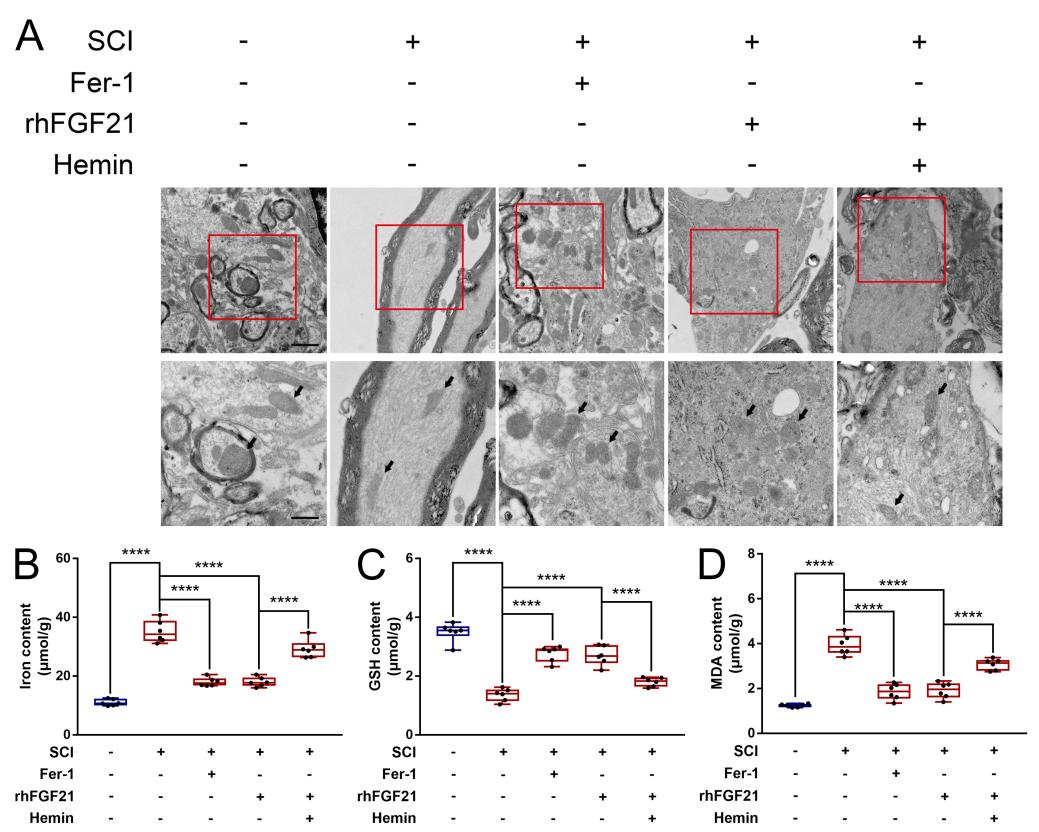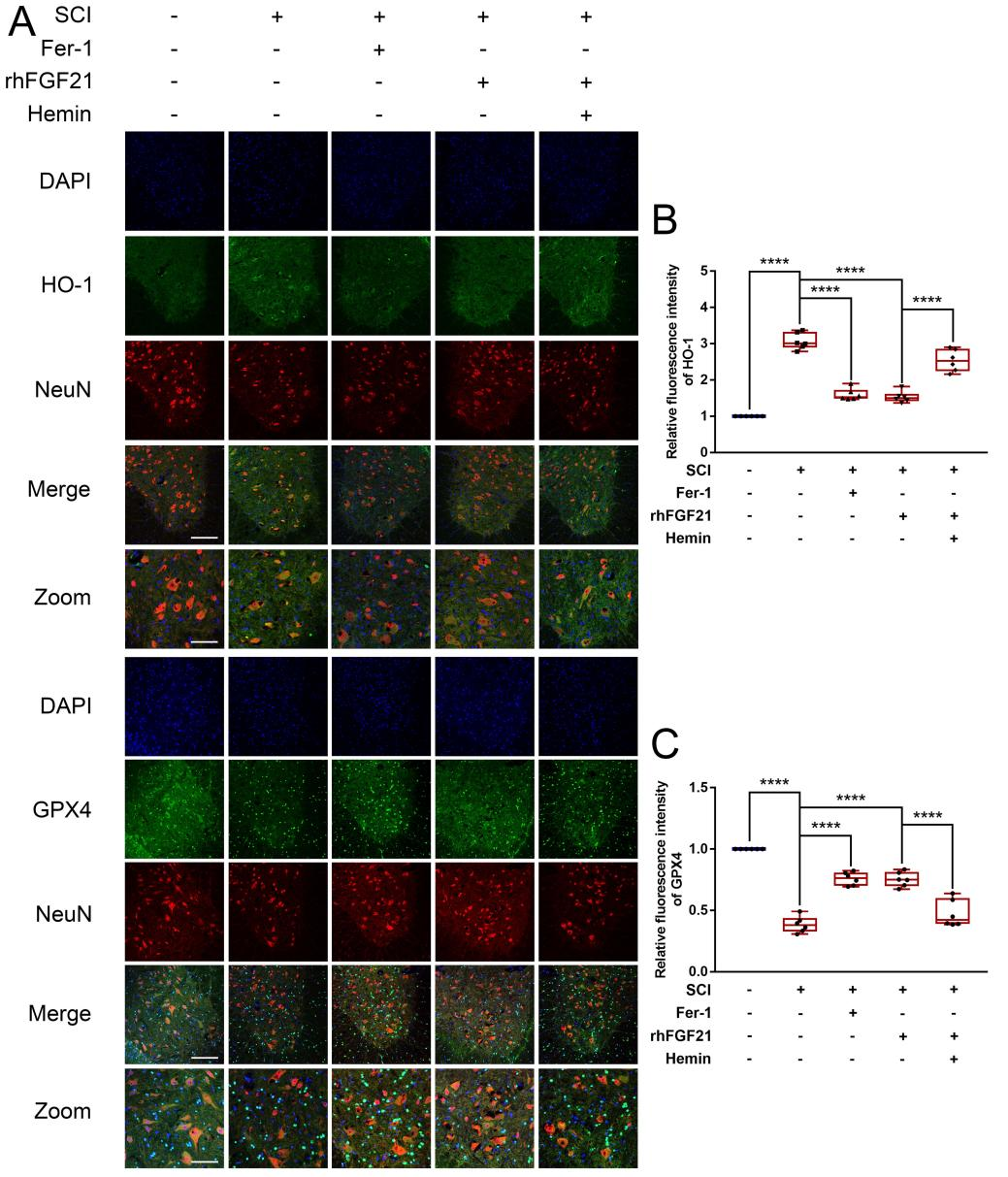NRR:张家港市第一人民医院林小龙团队揭示激活成纤维细胞生长因子21是治疗脊髓损伤的潜在方法
撰文:顾颀 ,沙卫平,黄群,王进,朱轶,徐天立,徐振华,朱前程,葛建飞,田守进,林小龙
脊髓损伤(SCI)是一种严重的中枢神经系统创伤性损伤,可导致脊髓受损部位以下的下肢功能障碍,甚至导致死亡[1,2]。脊髓损伤有原发性和继发性的病理生理表现。原发性损伤是一种不可逆的机械损伤,继发性损伤是可逆的。因此,减轻脊髓损伤后继发性损伤,促进残余神经元存活可能是保护脊髓损伤神经功能的关键。自噬、炎症、细胞凋亡、氧化应激和铁死亡通常与继发性损伤有关[3]。铁死亡是由铁依赖性脂质过氧化引起的细胞死亡级联反应,其生化特征是异常的铁代谢、铁诱导的活性氧(ROS)积累、谷胱甘肽过氧化物酶4(GPX4)抑制和脂质过氧化增加[4]。脊髓损伤后,急性期局部出血增加了损伤区域铁和ROS的积累,激活了铁死亡途径[5]。成纤维细胞生长因子21(FGF21)作为成纤维细胞生长因子超家族的成员,在脊髓损伤后表现出了强大的神经保护作用,外源性给予重组人FGF21(rhFGF21)可抑制神经元死亡,促进轴突延伸[6]。血红素加氧酶-1(HO-1),是一种II期酶,负责将血红素转化为胆绿素/胆红素、亚铁(Fe2+)和一氧化碳(CO)。有研究表明,FGF21可以通过促进HO-1的泛素化和降解来抑制肝细胞的铁死亡[7]。目前,FGF21在脊髓损伤后铁死亡中的作用尚不清楚,FGF21是否通过调控HO-1来影响铁死亡过程还有待进一步研究。
近期,张家港市第一人民医院林小龙团队在《中国神经再生研究(英文版)》(Neural Regeneration Research)上发表了题为“Fibroblast growth factor 21 inhibits ferroptosis following spinal cord injury by regulating heme oxygenase-1”的研究论文。在这项研究中,该团队使用SCI大鼠模型,证实了SCI后脊髓组织中的FGF21水平下降,铁死亡明显加重,但SCI后HO-1的表达迅速增加。此外,HO-1加重了SCI后的铁死亡,而FGF21通过下调HO-1抑制了铁死亡过程。因此,激活FGF21可能为SCI提供一种潜在的治疗方法。这些发现可以为FGF21在治疗SCI方面提供一个新的潜在的机制解释。顾颀和沙卫平为论文共同第一作者,林小龙和田守进教授为论文共同通讯作者。
在实验1中,为了探讨FGF21和HO-1在SCI后的变化趋势,该团队对SCI后第1,2,3,7,14和28天采集的脊髓组织进行了WB和qRT-PCR分析(图1)。FGF21的蛋白表达在SCI后第1天下降,在SCI后第2天达到最低水平(图1 A,B),qRT-PCR分析显示FGF21的mRNA表达有同样的趋势(图1 F)。然而,HO-1 mRNA和蛋白表达在SCI后迅速增加,并在SCI后第2天达到峰值(图1 A,C,G)。#br#
该团队将谷胱甘肽过氧化物酶4(GPX4)和4-羟基壬烯醛(4HNE)作为铁死亡相关的标记物纳入研究。GPX4的表达在SCI后2天迅速下降,第3天后缓慢上升。4HNE的表达在SCI后第2天达到高峰(图1 D,E,H,I)。GPX4和4HNE的表达趋势也表明,SCI后第2天可以作为一个合适的时间点进行药物干预。

图1. FGF21,HO-1,GPX4和4HNE在大鼠SCI后各时间点的mRNA和蛋白表达趋势(Gu et al., 2024)
在实验2中,研究者将大鼠随机分为5组(n=6): 假手术组(Sham),SCI组(SCI),SCI+ferrostatin-1治疗组(Fer-1),SCI+rhFGF21治疗组(rhFGF21)和SCI+rhFGF21+hemin治疗组(rhFGF21+hemin)。其中,rhFGF21为重组人FGF21(recombinant human FGF21),可以外源性补充FGF21;hemin为一种HO-1激动剂;ferrostatin-1(Fer-1)为一种铁死亡抑制剂,作为阳性对照。
该团队通过Nissl染色和Perls染色来评估神经元变性和铁蓄积的程度。脊髓切片的Nissl染色结果显示,正常的神经元是圆形的、深色的染色,而SCI后出现萎缩和淡紫色的神经元。Fer-1和rhFGF21处理都改善了神经元的形态改变,但hemin处理加重了神经元的萎缩(图2A,B)。脊髓切片的Perls染色显示,SCI组的铁阳性细胞明显多于Sham组。在Fer-1和rhFGF21组,铁阳性细胞明显减少,而rhFGF21+hemin组比rhFGF21组有更多的铁阳性细胞(图2A, C)。
此外,实验大鼠的Basso, Beattie and Bresnahan(BBB)运动评分在SCI后下降,28天后缓慢上升。Fer-1组和rhFGF21组的分数比SCI组增加得更快。rhFGF21+hemin组的BBB评分比rhFGF21组低。在倾斜板试验中,研究者观察到Fer-1组和rhFGF21组的大鼠能在倾斜板上保持姿势的倾斜角度高于SCI组,但rhFGF21组的倾斜角度高于rhFGF21+hemin组(图2D,E)。

图2大鼠BBB评分、倾斜板试验、Nissl染色和Perls染色的变化(Gu et al., 2024)
与SCI组相比,rhFGF21组和rhFGF21+hemin组的FGF21蛋白表达明显增加。然而,在rhFGF21治疗后,FGF21的mRNA表达无明显差异(图3 A,B,F)。与SCI组相比,Fer-1组和rhFGF21组的HO-1和4HNE的表达明显下降。然而,在hemin治疗后,HO-1和4HNE的表达增加(图3 A,C,E,G,I)。在Fer-1组和rhFGF21组中,GPX4的表达明显增加,而hemin处理则下调了GPX4的表达(图3 A,D,H)。

图3. 大鼠的FGF21、HO-1、GPX4和4HNE的mRNA和蛋白表达水平(Gu et al., 2024)
为了定量分析各组脊髓组织的铁死亡过程,研究者测量了铁、还原型谷胱甘肽(GSH)和过氧化脂质(MDA)的浓度(图4)。与SCI组相比,rhFGF21组的铁和MDA含量明显减少,GSH含量增加(图4B-D)。然而,与rhFGF21组相比,rhFGF21+hemin组的铁和MDA含量增加,GSH水平下降(图4B-D)。透射电子显微镜(TEM)图像显示,SCI组和rhFGF21+hemin组的脊髓神经元的线粒体有结构性的病理变化,包括线粒体的皱缩和线粒体嵴的减少或消失。然而,Fer-1组和rhFGF21组的线粒体结构和形态有所改善(图4 A)。这些结果也表明,FGF21抑制了SCI后大鼠的铁死亡,而HO-1则加重了铁死亡。

图4. 大鼠脊髓组织铁,GSH,MDA含量和透射电镜图片(Gu et al., 2024)
该团队通过对各组的脊髓组织切片进行免疫荧光染色,观察到HO-1和GPX4在脊髓前角的表达差异(图5A)。与WB和qRT-PCR结果相似,与SCI组相比,Fer-1组和rhFGF21组的HO-1表达下降,但与rhFGF21组相比,rhFGF21+hemin组的HO-1表达增加(图5 B,C)。GPX4的表达变化与HO-1相反,在Fer-1组和rhFGF21组增加,而在rhFGF21+hemin组减少(F图5 B,C)。这一发现也表明,FGF21通过抑制脊髓前角的HO-1表达而抑制了SCI诱导的铁死亡。

图5. 大鼠脊髓组织免疫荧光染色的HO-1和GPX4的表达(Gu et al., 2024)
综上所述,在SCI后的短时间内,FGF21在脊髓组织中的表达下降,而HO-1的水平显著增加。FGF21可以抑制HO-1表达,并进一步抑制SCI诱导的铁死亡。因此,激活FGF21可能为SCI提供一种潜在的治疗方法。此外,这些发现可以为FGF21在治疗SCI方面提供一个新的潜在的机制解释。
但是,也应注意该研究的局限性。首先,虽然通过qRT-PCR和WB分析了FGF21和HO-1的mRNA和蛋白表达,但仍然缺乏免疫组织化学(IHC)的直观量化。其次,即使BBB运动评分和斜板试验由两名观察者进行盲法观察,但由于缺乏评估功能恢复的关节运动学的视频分析,导致了相当主观的评估。由于这些局限性,还有很多延伸工作要做。
原文链接:https://doi.org/10.4103/1673-5374.387979
参考文献
[1]Li X, Liu D, Xiao Z, et al. Scaffold-facilitated locomotor improvement post complete spinal cord injury: Motor axon regeneration versus endogenous neuronal relay formation. Biomaterials. 2019;197:20-31
[2]Taccola G, Sayenko D, Gad P, et al. And yet it moves: Recovery of volitional control after spinal cord injury. Prog Neurobiol. 2018;160:64-81.
[3]Vismara I, Papa S, Veneruso V, et al. Selective modulation of A1 astrocytes by drug-loaded nano-structured gel in spinal cord injury. ACS Nano. 2020;14:360-371.
[4]Bersuker K, Hendricks JM, Li Z, Magtanong L, et al. The CoQ oxidoreductase FSP1 acts parallel to GPX4 to inhibit ferroptosis. Nature. 2019;575:688-692
[5]Meng FX, Hou JM, Sun TS. Effect of oxidative stress induced by intracranial iron overload on central pain after spinal cord injury. J Orthop Surg Res. 2017;12:24.
[6]Zhu S, Ying Y, Ye L, et al. Systemic administration of fibroblast growth factor 21 improves the recovery of spinal cord injury (SCI) in rats and attenuates SCI-induced autophagy. Front Pharmacol. 2020;11:628369
[7]Wu A, Feng B, Yu J, et al. Fibroblast growth factor 21 attenuates iron overload-induced liver injury and fibrosis by inhibiting ferroptosis. Redox Biol. 2021;46:102131.

第一作者 顾颀 张家港市第一人民医院骨科医师,硕士研究生

共同第一作者 沙卫平 中共党员 张家港市第一人民医院副院长 骨科主任医师,硕士生导师
江苏省生物医学工程学会智能医疗器械与装备装备委员会委员
江苏省医学会骨科学分会脊柱学组委员江苏省医学会骨科学分会骨质疏松组委员
江苏省中西医学会骨科分会脊柱学组青年委员
苏州市医学会骨科学分会脊柱学组委员张家港市医学会骨科分会主任委员

通讯作者 林小龙 中共党员 张家港市第一人民医院骨科科研秘书 副主任医师,医学博士,硕士生导师
中国康复医学会骨伤康复专业委员会科普工作组(数字化脊柱外科医工结合)委员
张家港市医药卫生学会骨科学青年委员会主任委员

共同通讯作者 田守进 中共党员 张家港市第一人民医院骨科科主任 主任医师
江苏省医学会第十届骨科学分会委员会委员(2020年)
江苏省医学会骨科学分会骨关节学组委员(2020年)
江苏省医学会骨科学分会骨关节炎学组委员(2022年)
江苏省骨科专业质量控制中心委员(2021年)
江苏省医师协会骨科医师分会第三届委员会委员(2020年)
苏州市医学会第二届骨科学分会常委(2021年)
苏州市医学会第二届骨科学分会关节外科学组组长(2022年)
苏州市中西医结合学会运动医学专业委员会副主委(2017年)
张家港市名医








